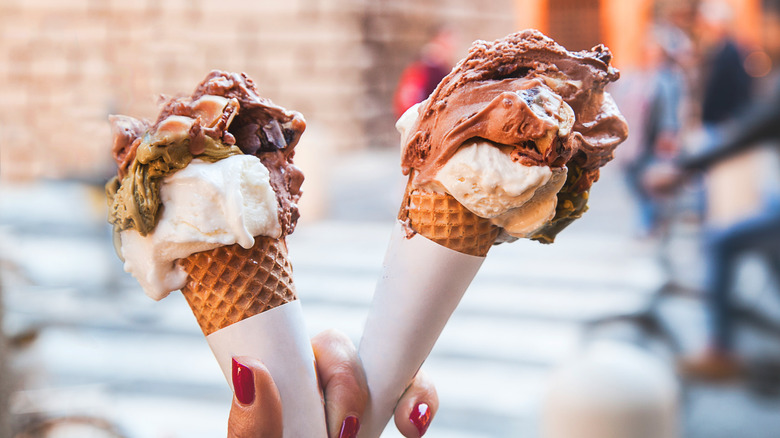Italy Might Start Fining Vendors Of Low-Quality Gelato
There's no reason to eat bad gelato in Italy. Ever since noblewoman Caterina de' Medici and her crew of chefs helped introduce the frozen dessert to Italians and the rest of Europe in the 1500s, gelato has been a sweet symbol of Italian summers for both locals and tourists. Today, streets in bustling cities and small villages alike are abundant with the rich yet airy concoction that is Italy's version of ice cream. That doesn't mean all of it is good. The Italian government is on a mission to change that — via a new law that would protect artisanal gelato.
Italy is no stranger to standardized food laws and regulations. The country closely examines the production of products like Parmigiano-Reggiano and Prosciutto di Parma, ensuring that the quality is worthy of DOP (Protected Designation of Origin) or IGP (Indication of Geographic Protection) status (via Eataly). Italy sells more protected food products than any country in the European Union, Politico reports. Now some Italian senators want to extend such safeguards to gelato, proposing legislation that would fine those who use unauthorized ingredients up to €10,000 (or approximately $12,000), according to Food and Wine.
How to tell if gelato is the real deal
The proposed gelato legislation is currently under review by the Italian senate's commerce and tourism commission, Food and Wine reports. If it passes, the only ingredients allowed in "real" Italian gelato would be milk, milk derivatives, eggs, and fresh fruit — so no hydrogenated fats or artificial flavors or dyes. The law would even cap the amount of air allowed to be incorporated into each batch. It's customary for artisanal gelato to contain 20 to 30 percent air due to vigorous mixing, hence its whipped texture, but some industrial versions contain more than twice that amount, senators suggest. Some artisans have already expressed support for the legislation, according to Il Messaggero.
Until there's a law against it, there's nothing stopping vendors from making suspicious, short-cut versions of gelato and calling it "artisanal." If you find yourself in Italy in the meantime, you can spot the fake stuff with a few key tips from The Local. First, metal tins (preferably lidded) are the proper gelato-storing receptacle, so beware of plastic tubs. Next, be suspicious of overly vibrant colors and gaudy displays; gelato made with real pistachios should be a muted green-brown, not electric green, and doesn't need to be piled sky-high with decorations to attract customers. Finally, pay attention to ingredients and flavors. Generally, seasonal fruits are a good sign, while offerings such as blue Puffo, or Smurf, might be a cue to find another gelateria.

